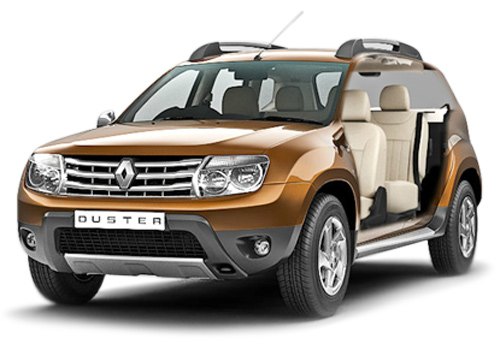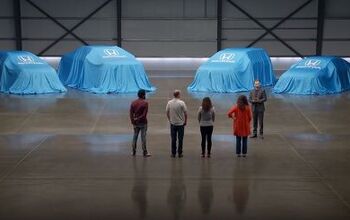Urban SUVs: Giving The People What The People Want

When the Renault Duster came out, I didn’t have to point it out to my wife. As soon as she saw one, she smiled and asked me what car was that. I explained to her that it was nothing more than our very own Logan, which is a sedan, on stilts. I explained how the handling would be worse, how it was less economic than our own car, how the trunk couldn’t hold as much luggage as our car did (but more than its hatch sister, the Sandero can). All to no avail. She listened, interested for once in cars, shook her head gravely, then said the damning words, “I want one.”
She is the target audience the Duster and others like the Ford EcoSport, Opel Mokka, or the upcoming Peugeot 2008 and 500X are aiming at. A mid-thirties, urbanite woman, with a job and a baby. A person with absolutely zero interest in going off-roading or speeding on a track. A woman who hates station wagons, tolerates minivans, but when she saw the unibody, SUV-looking Duster,, not knowing anything about it, decided on the spot to buy one.
What are her reasons? She’s a family woman with multiple obligations. Her commute is twenty minutes one way and soon she’ll be doing school runs. Of course, she lives in Brazil so her route is filled with potholes, speed bumps, radars, beggars and stoplight vendors. Her parking spot at home and work is tight. What does the Duster give her that the Logan or the Sandero, can’t?
It offers her some ground clearance to start with. She’ll be able to run over some of those bumps, float through the broken pavement and even parallel park without thought of scratching the wheels or breaking the car (or so she believes). The Duster is jacked up a few inches more than other regular cars. That gives her a better perch from which to control her surroundings and keep an eye on the traffic and various street vendors that approach her with gusto at every stoplight. When she parks it she’ll be amazed how though it looks so big inside, she can fit it into any standard issue parking spot at the mall or parking garages at places she has to go.
All the while, she’ll be enjoying an interior that is a notch above the regular Logan as Renault can ask more for this car, they can well afford to pay up for the plastic that cost a nickle more than the regular one and throw in a prettier radio for good measure. The seat fabrics will also be a (very small) step above the usual Renault fare and there’ll be some color and flash in the dash that’ll brighten up considerably the monotonous drab gray of most of the cars she’s driven or been in.
Finally, she’ll be the envy of her friends. When she says she drives a Logan, everyone and their aunt know that it’s just a low cost sedan that competes with the likes of a Chevy Classic. When she tells them she drives a Duster, her friends’ eyes will light up and she’ll savor the thought that they’ll think she is such a modern woman, driving such an avantgarde car. She’ll know she’s in tune with fashionistas the world over who somehow can’t buy that Range Rover just yet.
That pretty much sums up the reasons behind the rise of the softcore, car-based, mini SUV that I like to call Urban SUV. They’re not meant to go off road, and to the people who buy them, off road means that 5 km dirt road on the way to the country house. The longer suspension travel on the cars, not only enhances their tough looks, but adds to their comfort when riding along the bad roads prevalent the world over. The higher stance also offers a higher driving position that many equate with safety, not to mention the easier ingress and egress. The big doors make getting baby seats in it that much easier. The Urban SUV is based on a car and drives like pretty much like a car. It’s no biggie for people who have ever driven cars. In place riddled with violence, heavy traffic, tight spaces, speed cameras and little money, it’s a God-send.
Sales of cars like the Duster and others in the same vein grow and grow and then grow some more. Other makers have observed that little EcoSport and the waves it made in Brazil and other Latin American markets. The Dacia or Renault Duster rubbed it in on the home soil of many makes. Everybody is getting in on the action with their take. Cherokee for America, Mokka and many others for Europe. Even Honda showed a Fit-based, unimaginatively-named Urban SUV Concept in Geneva. They are slowly but surely eliminating enthusiasts’ choices: The pocket rocket, the sporty wagon, the BOF SUV that can go anywhere are finding less favor and funding in OEMs’ planning as they see who is bringing home the bacon.
My wife and the Duster featured in this article are just prototypical archetypes that explain the Urban SUV phenomenon. She is the kind of person the OEMs want. A middle class, young woman, living in a country where the car market is exploding. Potentially, she’s riding the wave of prosperity Brazilians are experiencing right now. BTW, that woman could be anywhere. Brazil, Russia, China, Indonesia, it doesn’t matter. Their worries are the same, they enjoy a lot of the same music. They all watch the same programs on cable TV. Remarkably, they want pretty much the same thing in a car, though what they want is something that enthusiasts don’t. They want practicality, economy, small but useable space. They don’t care for speed or going off road and they want to feel safe. What’s more, car makers want them, not us. They far outnumber enthusiasts.

More by Marcelo de Vasconcellos
Latest Car Reviews
Read moreLatest Product Reviews
Read moreRecent Comments
- MKizzy I was only into black cars and am on my third black sedan in a row after starting my car ownership life with an inherited blue vehicle. I am starting to change my mindset and will (probably) find another color for my next vehicle. I still love black, but in the 2020s, black vehicles are lost in a grayscale sea piloted by time and financially stressed owners prioritizing resale value and low maintenance over appearance.
- Cla65691460 will you look at that!...no "fix it again tony" jokes from the "best and brightest"
- Mike-NB2 When I ordered my Golf R a while back, I broke with my decades-long tradition of a black car, not because I wanted to branch out a bit, but because there is a certain blue hue that's associated with the R. That blue (Lapiz Blue) is through the exterior trim and interior of the car even if you go with black or white. It's the colour for the R. That's why I chose it. And I'm glad I did.On a related note, I was coming back from a meeting today (in a rental, not my car, so couldn't flag the guy down without looking odd) and came up on a Mk 7 Golf R that was driving rather slowly in the right lane of the highway. It appeared to be black, but as I got beside it, I noticed that it was one of the dark purple hues on the Spektrum palette that was available on the Mk 7. For those who don't remember it, there were standard colours and then there were 40 additional colours for $3500 more. Oddly, the driver was in his 70s, so whether it was his car or not, I don't know. No, that's no slight against an older person driving a performance car. I'll be 58 in a couple of months, so I'm not going to criticize him.
- MrIcky My car is header orange - so basically a safety cone. My trucks have always been white because scratches don't show up as much.
- FreedMike Yeah, this trend needs to die a painful death.


































Comments
Join the conversation
Cars used to be higher as there were still a lot of dirt and gravel in the US. As the infrastructure continues to revert to this state I am not surprised that people like this sort of vehicle. Not much else you can buy that has a tire with an actual sidewall nowadays.
"but adds to their comfort when riding along the bad roads prevalent the world over." There are plenty of bad roads here in the US because we ignore our infrastructure. I've driven in developing countries with better roads than certain parts of California.